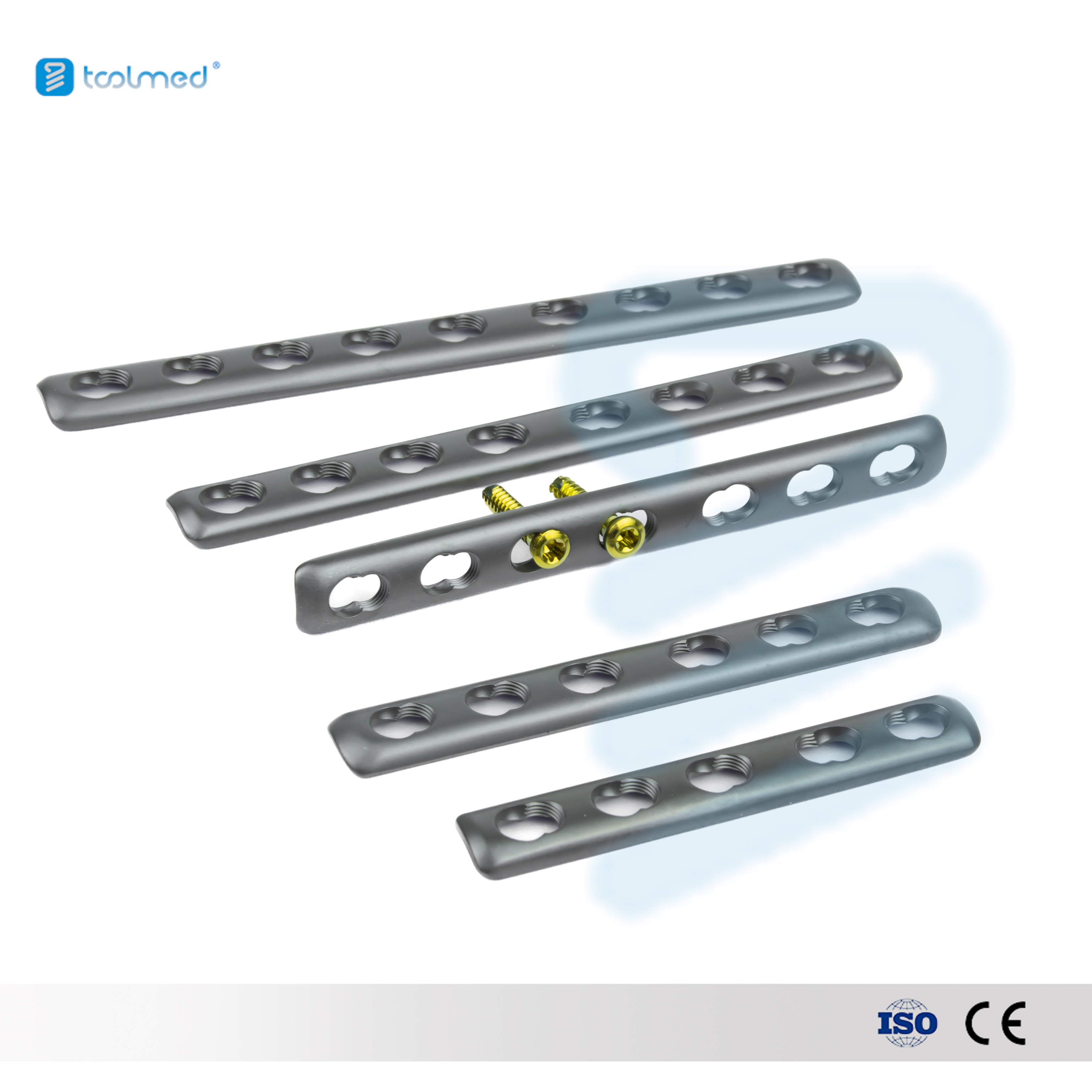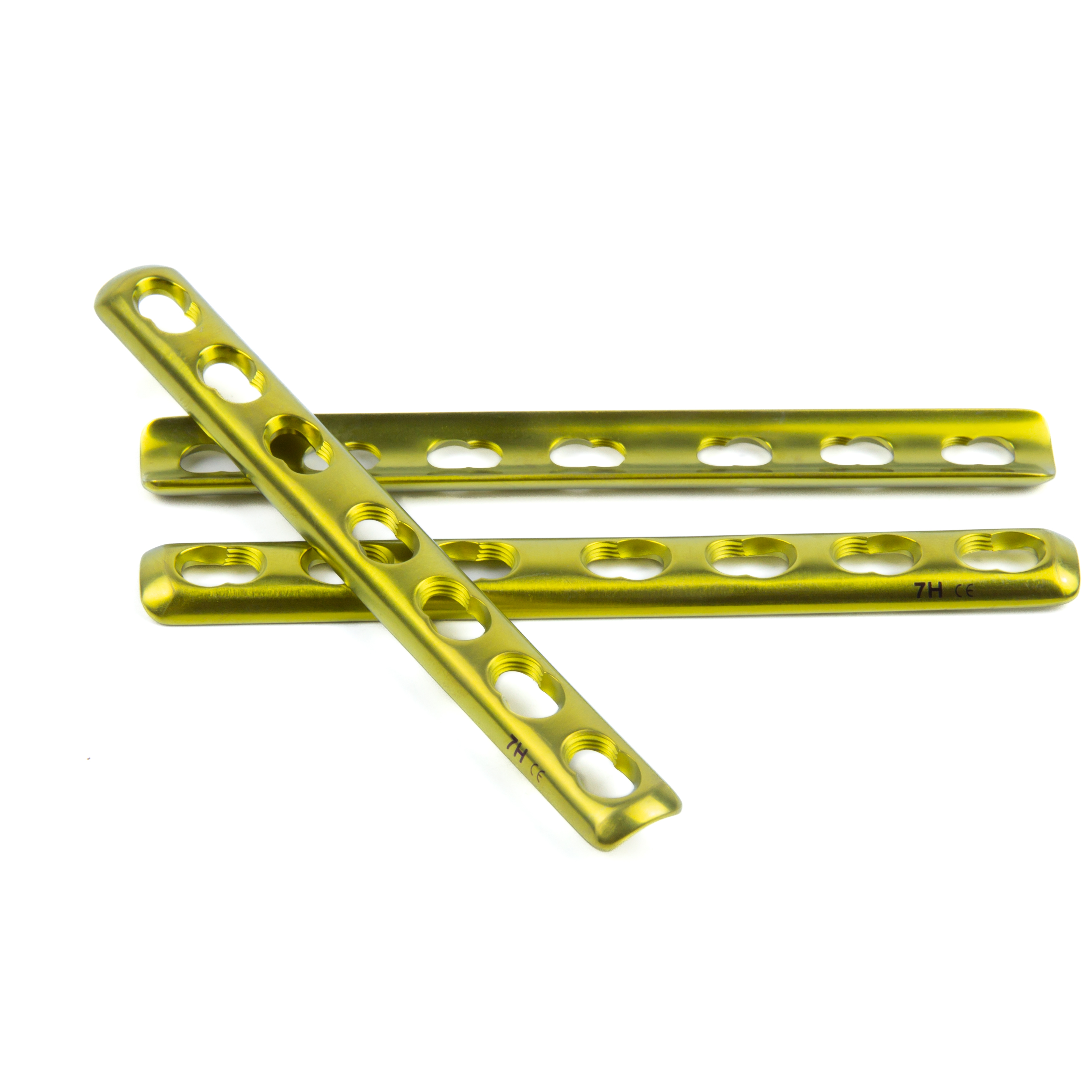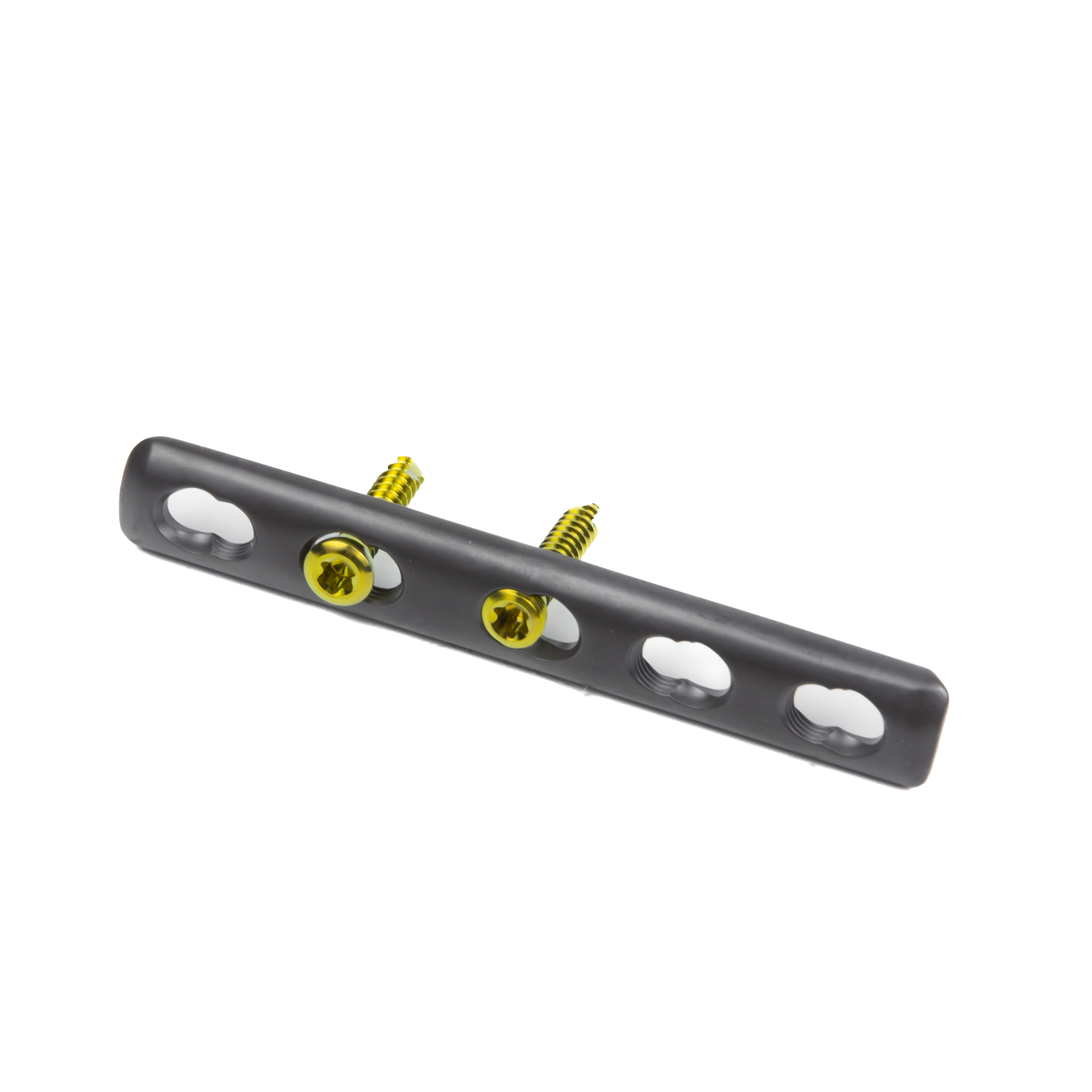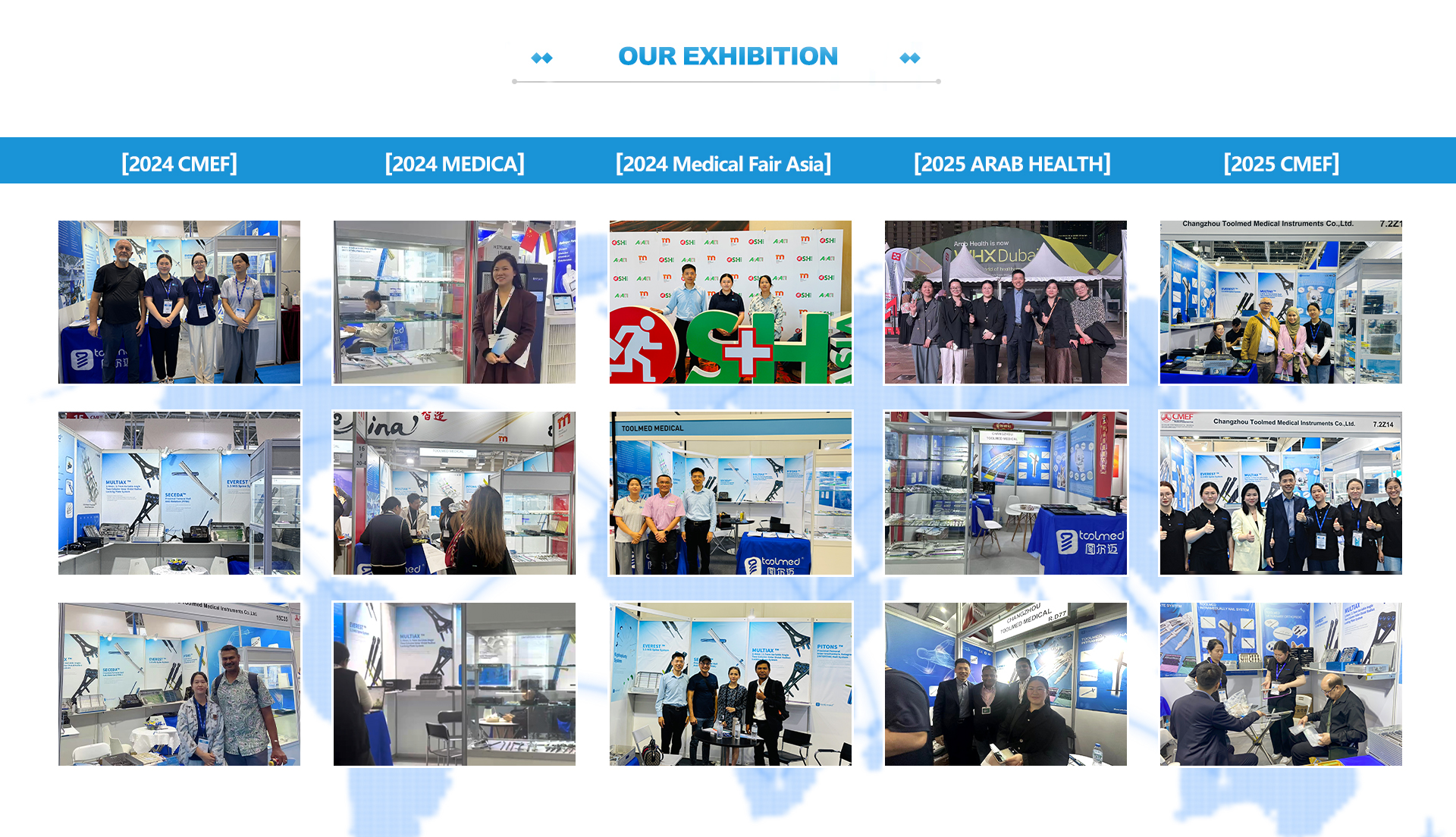The 1/3 Tubular Locking Plate is a specialized orthopedic implant designed for the internal fixation of small to medium bone fractures. This plate gets its name from its tubular cross-section, which is a low-profile design that minimizes soft tissue irritation. Unlike traditional plates, the screws of a locking plate system thread directly into the plate, creating a fixed-angle construct that provides superior stability. This feature is particularly beneficial in osteoporotic bone and comminuted fractures where traditional fixation might fail. The plate can be used for a wide range of applications, including fractures of the fibula, ulna, and radius, offering a reliable solution for complex surgical scenarios and promoting early patient recovery.
1/3 Tubular Locking Plate
TOOLMED
TA3
/
/
1 Pcs
5-7 days
| Availability: | |
|---|---|
Product Description
The locking screw-to-plate interface creates a fixed-angle construct, which provides superior stability and prevents screw back-out, especially in compromised or comminuted bone.
The plate's low-profile, one-third tubular cross-section minimizes irritation to surrounding soft tissues and reduces the need for hardware removal.
The plate is available in various pre-contoured shapes to match the anatomy of the specific bone, simplifying surgical application and providing an optimal fit.
The holes in the plate accept both locking and standard non-locking screws, allowing the surgeon to use a combination of techniques for compression or bridging, depending on the fracture pattern.
Crafted from a high-quality titanium alloy, the implant offers exceptional strength, biocompatibility, and fatigue resistance for reliable, long-term fixation.
The 1/3 Tubular Locking Plate is primarily indicated for the stable fixation of fractures of the fibula, ulna, radius, and other small long bones.
It is an ideal solution for metaphyseal fractures and comminuted fractures, where the locking screw technology provides superior stability without relying on plate-to-bone compression.
The plate is also suitable for internal fixation of osteotomies and for the treatment of non-unions and malunions in small bones.


| 3300-0101 | 5 holes |
| 3300-0102 | 6 holes |
| 3300-0103 | 7 holes |
| 3300-0104 | 8 holes |
| 3300-0105 | 9 holes |
| 3300-0106 | 10 holes |
| 3300-0107 | 12 holes |
| Product name | 1/3 Tubular Locking Plate |
| Material | TA3 |
| Diameter | / |
| Length | / |
| Application | Trauma Operation |
| Certificate | CE Certificate |
| Brand | TOOLMED |
| MOQ | 1 Pcs |
| OEM | Avaliable |
| Package | PE Inner Bag+Carton |
| Payment Method | T/T,Bank transfer, Western Union |
| Delivery Time | 5-7 days |
| Shipping | DHL EMS UPS TNT FEDEX |


The 1/3 Tubular Locking Plate is a specialized orthopedic implant that belongs to the family of locking plates. Its name describes its low-profile, one-third tubular cross-section. The key feature of this system is the locking screw, which threads into the plate itself, creating a fixed-angle construct. This is a significant improvement over traditional plates, as the stability is no longer dependent on the screw's purchase in the bone. This technology provides enhanced stability for complex fractures and in patients with poor bone quality, while the plate's low-profile design minimizes soft tissue irritation.
The primary application of the 1/3 Tubular Locking Plate is for the stable internal fixation of fractures in small to medium-sized bones. It is a commonly used implant for fractures of the fibula, particularly in the distal and middle thirds, as well as for fractures of the forearm (ulna and radius). It is also used for the fixation of metacarpal and metatarsal fractures. The locking technology makes it an excellent choice for comminuted fractures and for osteotomies, where the plate acts as an internal splint to support the bone until healing is complete.
The 1/3 Tubular Locking Plate offers several key advantages for fracture fixation. The fixed-angle construct provides superior biomechanical stability, which is crucial for achieving high healing rates. Because the plate does not need to be compressed against the bone, it helps to preserve the periosteal blood supply, which is vital for bone healing. The low-profile design and pre-contoured shapes simplify the surgical technique and reduce the risk of soft tissue irritation, which is a common issue with traditional plates.
This system's stability often allows for early mobilization and a faster return to daily activities, as the implant can support the physiological loads of the limb. Its versatility and reliability make it an invaluable tool for orthopedic surgeons treating a wide range of fracture patterns.
The biomechanics of the 1/3 Tubular Locking Plate are based on the principle of internal fixation without plate-to-bone compression. Once the locking screws are threaded into the plate, the entire construct acts as a single, rigid unit. This provides a "bridge" over the fracture site, which resists bending, twisting, and shortening forces. The fixed-angle stability is particularly effective in osteoporotic bone, where conventional screws may lose their hold. The load is shared between the bone and the implant, with the plate absorbing the majority of the bending and torsional forces, allowing the bone to heal with minimal stress.
The implantation of the 1/3 Tubular Locking Plate is a precise surgical procedure. After reducing the fracture, the plate is placed on the bone's surface. A dedicated targeting guide is used to drill and place the locking screws at the correct angle. The locking screws are then threaded into the plate, securing the construct. In some cases, a combination of standard and locking screws can be used to achieve compression across the fracture before the locking screws are applied. This technique ensures a stable and anatomically correct fixation, which is crucial for a successful outcome.
Following the implantation of a 1/3 Tubular Locking Plate, postoperative care typically involves early, controlled mobilization. Due to the inherent stability of the fixed-angle construct, patients are often able to begin early range of motion exercises or partial weight-bearing as prescribed by the surgeon. Physical therapy is a crucial component of recovery, focusing on restoring joint function and muscle strength. Regular clinical and radiographic follow-up appointments are essential to monitor fracture healing and ensure the implant remains stable throughout the recovery process.
The 1/3 Tubular Locking Plate is a highly effective and versatile implant for the stable fixation of small bone fractures. Its innovative locking technology, combined with a low-profile and anatomical design, provides surgeons with a reliable tool for achieving excellent clinical outcomes. By promoting high stability, preserving bone blood supply, and facilitating early patient mobility, the 1/3 Tubular Locking Plate leads to a faster and more complete recovery for patients.
In a conventional plate, the screws only hold the plate to the bone by compression. In a locking plate, the screws lock into the plate itself, creating a fixed-angle construct. This provides superior stability, especially in comminuted fractures or in osteoporotic bone.
A low-profile plate is thinner and less bulky, which reduces the risk of soft tissue irritation and discomfort. This can minimize the need for a second surgery to remove the implant after the bone has healed.
The plate is designed to be a permanent implant. However, it can be removed once the fracture has fully healed if the patient experiences pain or irritation from the hardware.
No, this plate is specifically designed for small to medium-sized bone fractures. Other, larger plates are used for major bones like the femur or tibia.
A fixed-angle construct provides powerful stability that is independent of the bone quality. It acts as an internal "splint" or "bridge" over the fracture, preventing the bone from collapsing or rotating and allowing it to heal naturally.



We offer fast and reliable global shipping. Standard lead times range from 7 to 15 working days, depending on order quantity and customization requirements. Express delivery options are also available upon request.
Yes, we ship to most countries worldwide. We work with trusted logistics partners to ensure timely and secure delivery.
We accept a variety of payment options, including T/T (bank transfer), L/C, and PayPal for smaller orders. Payment terms can be discussed based on order volume and partnership agreements.
Yes, samples are available for evaluation. Please contact our sales team to request product samples and shipping arrangements.
Absolutely. We offer OEM/ODM services including custom packaging, branding, and product development tailored to your specifications.
Links
Contact Us